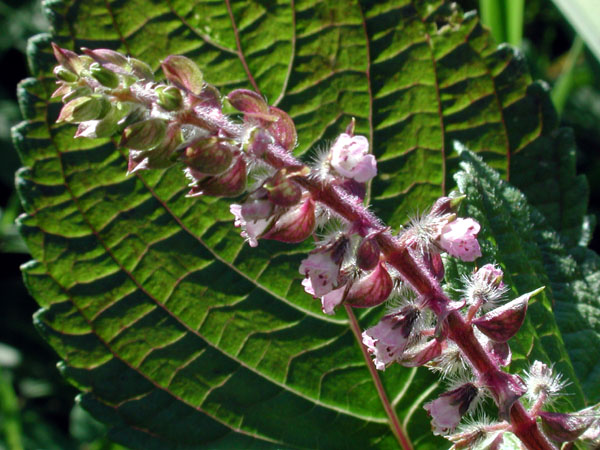
Perilla frutescens
(http://www.delawarewildflowers.org/perilla_frutescens.jpg)
The two Japanese varieties are Perilla frutescens var. crispa and Perilla frutescens var. japonica. Perilla frutescens var. crispa is the green leaf variety called shiso in Japanese and Zi Su in Chinese. Perilla frutescens var. japonica is the red leaf variety called egoma in Japanese.
Carbonized seed cakes have been recovered in vessels from archaeological sites dating to the Jomon Period. The seeds are also used today in Korea and Japan for making a cooking oil. If you look for it in an Asian grocery you may find it labeled as "wild sesame" oil. The leaves are used in modern Japanese cooking either fresh or pickled.You may have seen it in with Japanese pickled plums (or more properly a type of apricot) called umeboshi. The leaves are responsible for the pink color that the fruit takes on.
drk15@cornell.edu
I am interested in how mixed subsistence economies function, especially how nomadic pastoralist's use plant food or supplimentary agriculture practices- somtimes known as agropastoralists. I have conducted paleoethnobotantical invesitgations in past summers to help investigate these questions. During the summer of 2005, I worked in China at the Chinese Academy of Social Sciences Institute of Archaeology with Dr. Zhao Zhijun, and also worked on two field projects in Kazakhstan. One was in Northern Kazakhstan under the direction of Dr. Sandra Olsen of the Carnegie Museum of Natural History, and the other in Southern Kazakhstan was under the direction of Prof. Michael Frachetti. The summer of 2004 I undertook sample collection and field work on projects in Taiwan and Mongolia.
I completed my Master's of Arts degree in Dec. 2004 as part of the
Archaeological Program in
the Anthropology
Department
at Washington University in St. Louis .
My Master's thesis focused on the analyzing
paleoethnobotanical
samples from Hokkaido,
Japan excavated under the supervision
of Professor Gary Crawford
of the University of Toronto. The site was excavated in 1990 with the
help
of Earthwatch volunteers and the generous support of the Eniwa Board of
Education and Hokkaido University. I looked at samples from two
house floors, one dating
to between 3600-2500 BCE and the other dating to circa CE 700. The
people of this later period are direct ancestors of the
Ainu
people of today. However, contrary to popular belief, the ancestral
Ainu
did not solely depend on hunting/fishing and gatherering. They grew
several
grains including foxtail millet (Setaria
italica ssp. italica),
broomcorn/proso millet (Panicum miliaceum ssp.
miliaceum) and barnyard millet (Echinochloa crus-galli var.
utilis
or E. utilis), without
becoming commited agriculturalists.
My MA analysis looked at how these Northern Japanese populations, in
both
time periods, interacted with their environment to create subsistence
strategies that may not fit into our traditional conceptions of either
hunter-gatherers or agriculturalists, but rather reflect a broad
spectrum of practices. Click here for my MA
abstract
in English and
Japanese.
I have additional paleoethnobotanical experience and archaeological field experience in the American Southwest, where I worked at the Museum of New Mexico, Office of Archaeological Studies (OAS) in Santa Fe. My field school experience was on San Salvador Island, in the Bahamas. I conducted ethnoarchaeological field research, relating to houses, households and space-use, in Nepal during the fall of 1999 while an undergraduate as part of CNSP. I completed my undergraduate degree in the Anthropology Department and Archaeology Program at Cornell University, Ithaca NY.
updated Oct. 24, 2006